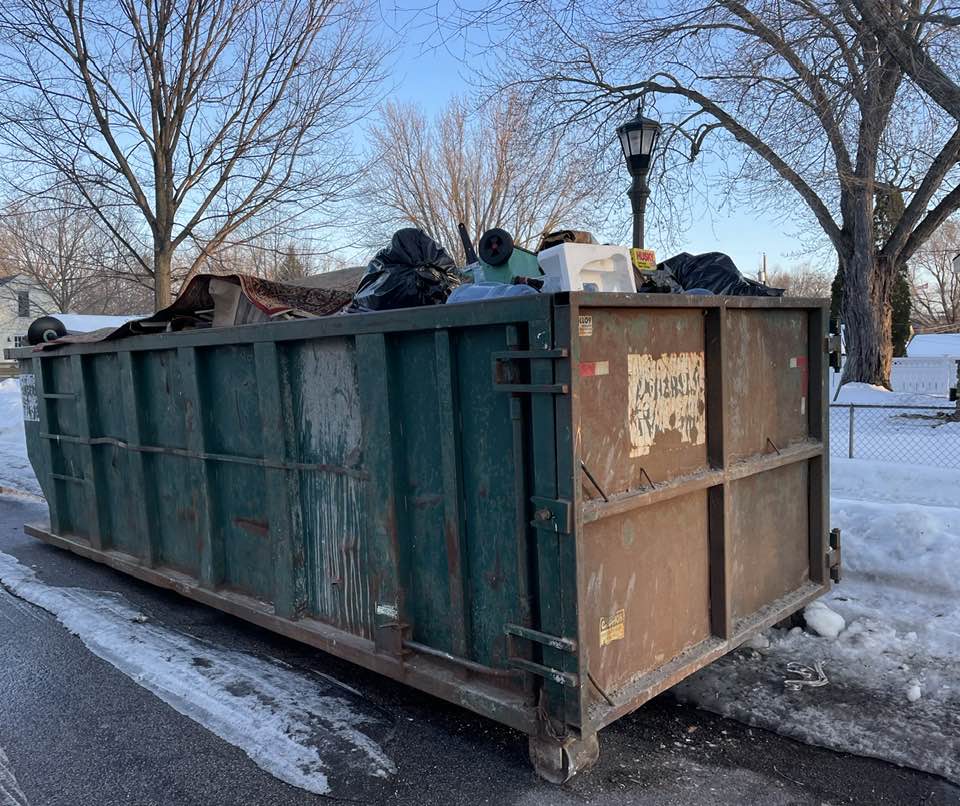MARCH 5, 2023 – (Cont.) Then one day late last fall I saw a “NOTICE” taped to the side door of the house. The city was finally taking action. But if St. Paul is slow to plow its streets after a snowstorm, the city’s even slower about addressing troubled properties. Only last week was the dead fir tree finally cut down and cut up (though not hauled away), but the house itself remained untouched.
Finally, on Friday I saw lights, camera . . . action. A beat-up pickup truck and a panel van were parked outside and a group of four or five workmen dressed in attire appropriate for the job were busily clearing out the property. One man was cutting up the remains of the tree into more manageable pieces. The rest of the crew were hauling stuff out of the house and tossing it into the industrial-size dumpster parked on the street. They’d been at work for a while, as revealed by the mountain of junk that was now higher than the top of the dumpster.
As I walked past the big, steel container, I noticed two hardcover books lying on top near the side. A few paces beyond the dumpster, my curiosity kicked in. Books! The containers, the carpet, cheap floor lamp sticking up wouldn’t reveal much about the people connected to the house, but books? Yes, potentially they’d tell me something.
I retraced my steps, and after ensuring no one was looking (the high container hid me from view of the workmen), I snatched the top book off the dumpster. It was an old Houghton Mifflin textbook, Microeconomics: Analysis and Practical Application. I knew enough from undergraduate economics courses that this was not an Economics 101 textbook. I never took microeconomics, but I do remember economics majors complaining about the rigors of that subset of the “dismal science.”
I was impressed. Someone associated with that house had found their way educationally to something beyond the introductory level of college economics. Had one or both of the long-gone owners lived in academia—the vocational home for many folks in the area? Had one of their kids been a serious scholar? What were the odds the scholar-kid was not the wayward kid—the owner of the long-gone red pickup with whiskey plates?
I tossed the book back on the junk heap confined to the dumpster. As I slipped and slid my way to “Little Switzerland,” I let my imagination off the leash to speculate about . . . the story in the dumpster, soon to be laid to rest in a nearby landfill.
My mental wonderings took me back to the big, Victorian haunted house across the street from Matheny’s corner store (See 7/28 – 30/22 blog posts) to which we made daily candy runs when I was a kid. A set designer for horror films couldn’t have devised a better stage than that all-gray, abandoned house. Built in circa 1910, the dwelling’s original glory could be readily imagined despite the house’s extreme dilapidation. All paint and glazing had disappeared decades before, and the remains of a grand staircase leading to the second floor projected the same outline of former grandeur that the Parthenon ruins give to that monument of ancient elegance. A large window opening in front gave passersby an interior view of what was once attested to local wealth, pride and self-importance. (Cont.)
(Remember to subscribe to this blog and receive notifications of new posts by email.)
© 2023 by Eric Nilsson
